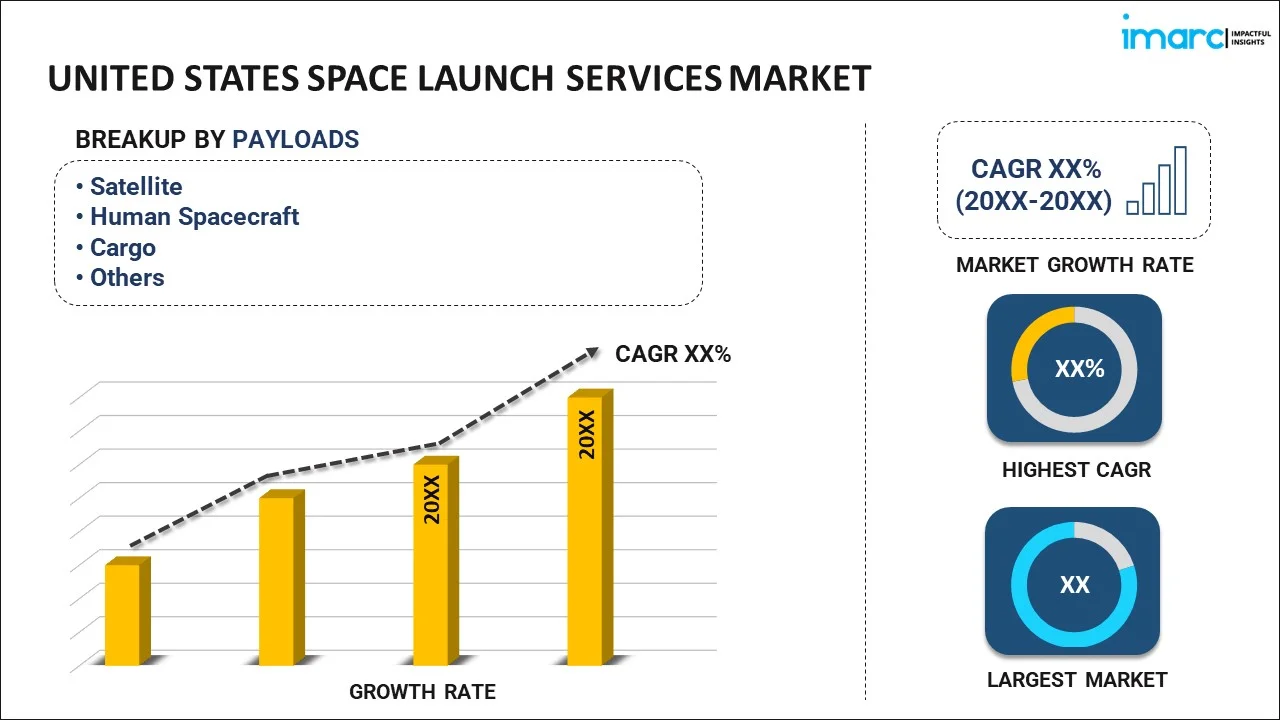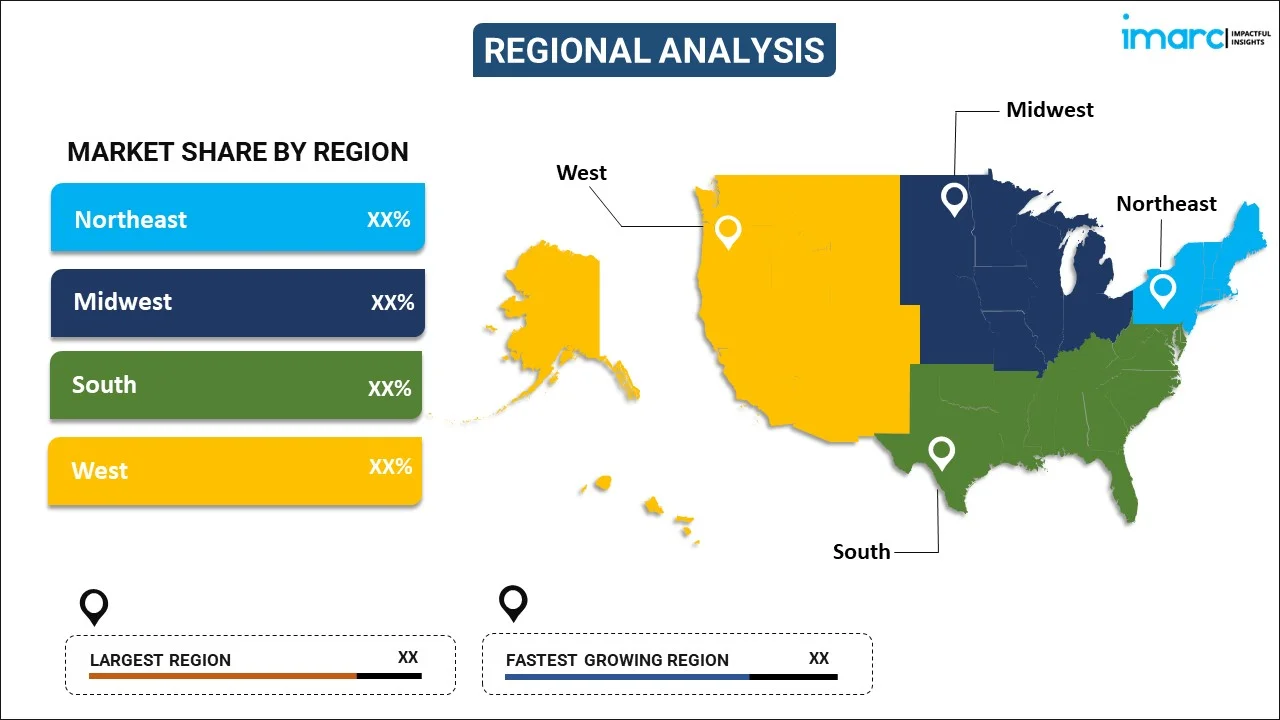
United States Space Launch Services Market Report by Payload (Satellite, Human Spacecraft, Cargo, Testing Probes, Stratollite), Launch Platform (Land, Air, Sea), Service Type (Pre-Launch, Post-Launch), Orbit (Low Earth Orbit (LEO), Medium Earth Orbit (MEO), Geosynchronous Orbit, Polar Orbit), Launch Vehicle (Small Launch Vehicle, Heavy Launch Vehicle), End User (Government and Military, Commercial), and Region 2025-2033
Market Overview:
United States space launch services market size is projected to exhibit a growth rate (CAGR) of 14.7% during 2025-2033. The increasing demand for small satellites, including CubeSats, for various applications such as Earth observation, communication and scientific research, is driving the market.
|
Report Attribute
|
Key Statistics
|
|---|---|
|
Base Year
|
2024 |
|
Forecast Years
|
2025-2033
|
|
Historical Years
|
2019-2024
|
| Market Growth Rate (2025-2033) | 14.7% |
Space launch services involve the transportation of payloads, such as satellites or scientific instruments, from Earth into space using launch vehicles, commonly known as rockets. These services play a crucial role in various fields, including telecommunications, Earth observation, scientific research, and national security. Space launch providers design, build, and operate rockets to carry payloads into specific orbits or trajectories. The services encompass a range of activities, from launch vehicle manufacturing to launch operations and mission planning. Companies and government agencies offer space launch services catering to diverse customer needs. The space launch industry is dynamic, with continuous advancements in technology and a growing emphasis on cost efficiency, reusability, and sustainability to enhance accessibility to space. As space exploration and satellite deployment continue to expand, space launch services remain integral to advancing the understanding of the cosmos and facilitating connectivity.
United States Space Launch Services Market Trends:
The United States space launch services market is experiencing robust growth, driven by a confluence of factors that underscore the expanding horizons of space exploration. Firstly, advancements in satellite technology are propelling the demand for frequent and reliable launches, necessitating a surge in launch services. Moreover, the increasing number of small satellite constellations for applications ranging from communication to Earth observation is fostering a burgeoning market. Additionally, the rise of commercial space endeavors has intensified competition and innovation in the sector, further fueling market expansion. Besides this, government initiatives and partnerships with private space entities are playing a pivotal role in stimulating the market. Collaborative efforts between space agencies and commercial launch service providers are accelerating the development of next-generation launch vehicles and technologies. Simultaneously, the growing interest in space tourism that is opening up new avenues for space launch services, with companies exploring ways to cater to the emerging space tourism sector, is expected to drive the United States space launch services market in the coming years.
United States Space Launch Services Market Segmentation:
IMARC Group provides an analysis of the key trends in each segment of the market, along with forecasts at the country level for 2025-2033. Our report has categorized the market based on payload, launch platform, service type, orbit, launch vehicle, and end user.
Payload Insights:

- Satellite
- Small Satellite (Less Than 1000 Kg)
- Large Satellite (Above 1000 Kg)
- Human Spacecraft
- Cargo
- Testing Probes
- Stratollite
The report has provided a detailed breakup and analysis of the market based on the payload. This includes satellite (small satellite (less than 1000 kg) and large satellite (above 1000 kg)), human spacecraft, cargo, testing probes, and stratollite.
Launch Platform Insights:
- Land
- Air
- Sea
A detailed breakup and analysis of the market based on the launch platform have also been provided in the report. This includes land, air, and sea.
Service Type Insights:
- Pre-Launch
- Post-Launch
The report has provided a detailed breakup and analysis of the market based on the service type. This includes pre-launch and post-launch.
Orbit Insights:
- Low Earth Orbit (LEO)
- Medium Earth Orbit (MEO)
- Geosynchronous Orbit
- Polar Orbit
A detailed breakup and analysis of the market based on the orbit have also been provided in the report. This includes low earth orbit (LEO) and medium earth orbit (MEO), geosynchronous orbit, and polar orbit.
Launch Vehicle Insights:
- Small Launch Vehicle
- Heavy Launch Vehicle
The report has provided a detailed breakup and analysis of the market based on the launch vehicle. This includes small launch vehicle and heavy launch vehicle.
End User Insights:
- Government and Military
- Commercial
A detailed breakup and analysis of the market based on the end user have also been provided in the report. This includes government and military and commercial.
Regional Insights:

- Northeast
- Midwest
- South
- West
The report has also provided a comprehensive analysis of all the major regional markets, which include Northeast, Midwest, South, and West.
Competitive Landscape:
The market research report has also provided a comprehensive analysis of the competitive landscape. Competitive analysis such as market structure, key player positioning, top winning strategies, competitive dashboard, and company evaluation quadrant has been covered in the report. Also, detailed profiles of all major companies have been provided.
United States Space Launch Services Market Report Coverage:
| Report Features | Details |
|---|---|
| Base Year of the Analysis | 2024 |
| Historical Period | 2019-2024 |
| Forecast Period | 2025-2033 |
| Units | Billion USD |
| Scope of the Report | Exploration of Historical and Forecast Trends, Industry Catalysts and Challenges, Segment-Wise Historical and Predictive Market Assessment:
|
| Payloads Covered |
|
| Launch Platforms Covered | Land, Air, Sea |
| Service Types Covered | Pre-Launch, Post-Launch |
| Orbits Covered | Low Earth Orbit (LEO), Medium Earth Orbit (MEO), Geosynchronous Orbit, Polar Orbit |
| Launch Vehicles Covered | Small Launch Vehicle, Heavy Launch Vehicle |
| End Users Covered | Government and Military, Commercial |
| Regions Covered | Northeast, Midwest, South, West |
| Customization Scope | 10% Free Customization |
| Post-Sale Analyst Support | 10-12 Weeks |
| Delivery Format | PDF and Excel through Email (We can also provide the editable version of the report in PPT/Word format on special request) |
Key Questions Answered in This Report:
- How has the United States space launch services market performed so far and how will it perform in the coming years?
- What has been the impact of COVID-19 on the United States space launch services market?
- What is the breakup of the United States space launch services market on the basis of payload?
- What is the breakup of the United States space launch services market on the basis of launch platform?
- What is the breakup of the United States space launch services market on the basis of service type?
- What is the breakup of the United States space launch services market on the basis of orbit?
- What is the breakup of the United States space launch services market on the basis of launch vehicle?
- What is the breakup of the United States space launch services market on the basis of end user?
- What are the various stages in the value chain of the United States space launch services market?
- What are the key driving factors and challenges in the United States space launch services?
- What is the structure of the United States space launch services market and who are the key players?
- What is the degree of competition in the United States space launch services market?
Key Benefits for Stakeholders:
- IMARC’s industry report offers a comprehensive quantitative analysis of various market segments, historical and current market trends, market forecasts, and dynamics of the United States space launch services market from 2019-2033.
- The research report provides the latest information on the market drivers, challenges, and opportunities in the United States space launch services market.
- Porter's five forces analysis assist stakeholders in assessing the impact of new entrants, competitive rivalry, supplier power, buyer power, and the threat of substitution. It helps stakeholders to analyze the level of competition within the United States space launch services industry and its attractiveness.
- Competitive landscape allows stakeholders to understand their competitive environment and provides an insight into the current positions of key players in the market.
Need more help?
- Speak to our experienced analysts for insights on the current market scenarios.
- Include additional segments and countries to customize the report as per your requirement.
- Gain an unparalleled competitive advantage in your domain by understanding how to utilize the report and positively impacting your operations and revenue.
- For further assistance, please connect with our analysts.
 Inquire Before Buying
Inquire Before Buying
 Speak to an Analyst
Speak to an Analyst
 Request Brochure
Request Brochure
 Request Customization
Request Customization




.webp)




.webp)












